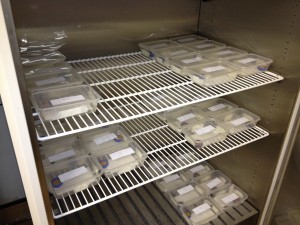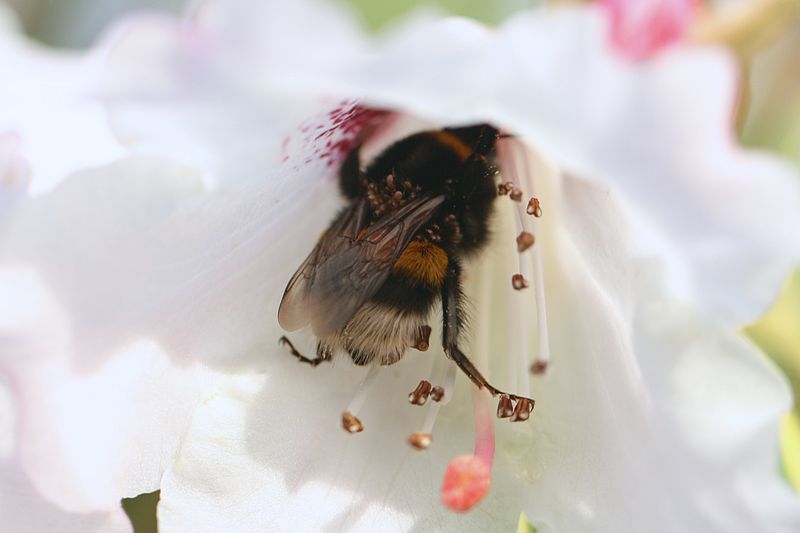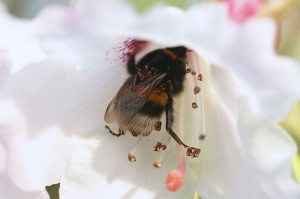In a previous blog post I wrote about my work on “toxic nectar.” This paradoxical phenomenon occurs when potentially deterrent or toxic plant secondary compounds, usually associated with defense against herbivores, are found in floral nectar rewards. Throughout my PhD I’ve spent countless hours in the lab performing experiments on toxic nectar, discussed this work at Nerd Club, and presented it at conferences. After what seems like an awfully long time, our first article on nectar toxins has been published in the Journal of Experimental Biology. Here I want to describe what I think are the most exciting findings of the study, and also talk about how this work came to be part of my PhD.
When I first started my PhD I had what seemed like a never-ending list of questions about nectar toxins: do they impact plant fitness? What about pollinator survival? Are there sublethal costs to pollinators that ingest nectar toxins? But before we could tackle these bigger-picture concepts, we kept on coming back to a very simple question: are bees deterred by naturally occurring concentrations of secondary compounds in floral nectar?
We know that many plant secondary compounds, such as alkaloids, phenolics, and terpenes, play a role in deterring herbivores form consuming plant tissues, and that’s why toxic nectar is such a paradox. Why would plants have deterrent compounds in a tissue that is meant to act as a reward for pollinating flower-visitors? Nectar secondary compounds, however, tend to occur at much lower concentrations than those found in leaf or floral tissues. Previous work found that whether or not bees will forage on artificial nectar containing secondary compounds depends on ecological context, i.e. the availability of other food sources. However most work on this subject focuses on only one compound (gelsemine) and tests concentrations that are well above those found in floral nectar.
One might hypothesize that secondary compounds at nectar-relevant concentrations should not be deterrent to pollinators. If nectar toxins do deter legitimate pollinators, plant pollination and hence reproductive success could suffer, leading to selection for lower concentrations of nectar compounds. In addition, the direct impacts of nectar toxins on pollinators are still understudied; deterrence behavior might indicate a cost in terms of health or fitness for the pollinators. So we were convinced it was well worth determining deterrence thresholds for several of the most common/popular nectar toxins, and comparing these thresholds to nectar-relevant concentrations, but how did we do it?
The experimental design was very simple (my favorite kind!); we used an economically and ecologically important pollinator, Bombus terrestris, in a series of controlled, paired laboratory bioassays. In each assay, we offered bees two solutions of identical sugar content, one containing a secondary compound of interest and one without it. We repeated this 24-hour assay at a range of concentrations that included the nectar relevant dosage for each compound we tested. The deterrence threshold was determined when bumblebees significantly preferred the sucrose solution over the sucrose solution containing the compound. We also measured the total food consumed and bumblebee survival. I spent a lot of time in the laboratory and the bee room, weighing feeding tubes and counting dead bees; I’m not going to lie, I may have succumbed to talking to my bees now and again. It gets lonely in the lab! It was all worth it in the end though, because what we found was pretty interesting.

Our experiments showed that bumblebees are actually rather bad at detecting nectar toxins. The most deterrent compound was the alkaloid quinine, which was avoided at concentrations as low as 0.01 mM. All the other compounds we tested (caffeine, nicotine, amygdalin, and grayanotoxin) had deterrence thresholds 7-60 times greater than the concentration range naturally found in nectar. Previous work on the honeybee found that it too has poor acuity for the detection of nectar toxins, especially compared to insects in the orders Diptera and Lepidtopera. So why is it that social generalist bee species are relatively insensitive to the plant secondary compounds in their food? One hypothesis we highlighted in the discussion is that the relationship between bees and plants is largely mutualistic, as opposed to the antagonist interactions between plants and herbivores. There may not be strong enough selection pressure on bees to develop more sensitive gustatory receptors, especially because in eusocial bee species, individual bees are the consumers, but selection pressures act on the colony as the reproductive unit.
For decades, researchers of plant-animal interactions have been asking how and why toxic nectar evolved and is maintained in plant populations. Our work helps us to better understand the functional significance of toxic nectar. If legitimate pollinators fail to be deterred by nectar compounds at low concentrations, the plant is less likely to suffer from reduced pollination. This trait therefore may be maintained in plant populations, especially if it confers some sort of fitness advantage to the plant. What kind of fitness advantage could these compounds provide you ask? There are a plethora of possibilities, including antimicrobial resistance and selection against more sensitive nectar robbers or thieves. Possibly the presence of the compounds in nectar is simply a consequence of defense of other plant tissues. The results from our study, however, suggest that these other factors affecting nectar secretion and production are more likely to select for the production of toxins in nectar of bee pollinated plants, rather than pollinator preference.
Check the paper for more details and to read the whole story!
Author: Erin Jo Tiedeken, tiedekee[at]tcd.ie, @EJTiedeken
Images: Wikicommons and E.J. Tiedeken


